

Left: European conger (Conger conger), Dorset;
(Photo by Wreckferret)
Right: Daggertooth pike conger (Muraenesox cinereus), Izu;
(Photo by UmizaruGoh)
Previously, I talked about the moray eels (F. Muraenidae), which are star attractions for divers all over the world, and the snake eels (F. Ophichthidae), which are not as charismatic, but still attract some attention. This post will talk about 2 other families of eels which will be less familiar to people diving in Southeast Asian waters, the conger eels (F. Congridae) and the pike conger eels (F. Muraenesocidae).
Conger eels are not familiar to us living in Southeast Asia, although those living in temperate countries might have encountered various species of conger eels in fish markets.
Conger eels are a widespread family of 150 known species, distributed in the Atlantic, Indian and Pacific Oceans. A great deal of species are found only in the ocean depths, so very little is known about these deepwater species.

European conger at Lake District Coast Aquarium, Maryport;
(Photo by Nick Landells)
The most familiar conger eel species is the European conger, which lives in the eastern Atlantic, from Norway and Iceland, to the Mediterranean and Black Sea, to Senegal in West Africa. While it is known to inhabit shallow inshore waters, it has also been recorded to occur at great depths, more than a kilometre beneath the surface. While it lives near the coast when young, as the European conger grows older, it moves into deeper waters. The European conger is also the largest member of its family, and is known to reach 3 metres in length.
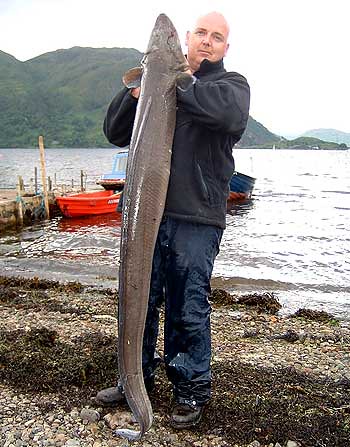
European conger caught at Loch Etive, Scotland;
(Photo by Fishing-Argyll)
Other members of the genus are found along the Atlantic coasts of North and South America, in southern Africa, along the coast of East Asia, and in Australia and New Zealand as well. These are among the few conger eel species that can be found in inshore waters, and most of these inshore species support some sort of fishery. While the European conger can be found in fish markets throughout Europe, its counterpart in North America is the American conger (Conger oceanicus). The southern conger (Conger verreauxi) supports fisheries in southern Australia and New Zealand, as does the cape conger (Conger wilsoni), which is also found in the waters around off South Africa.
The commercially important conger eel species in Japan is the white-spotted conger (Conger myriaster). It is marketed as anago (穴子), to differentiate it from the more familiar unagi (鰻), which comes from freshwater eels (F. Anguillidae).
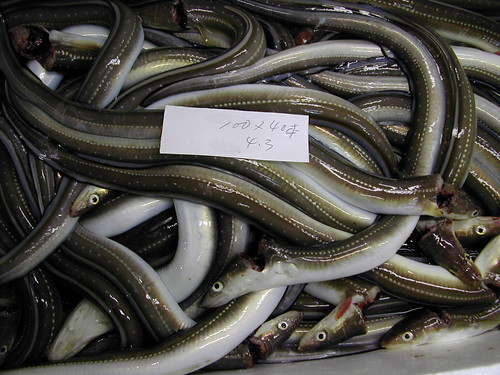
White-spotted conger, Tsukiji Fish Market;
(Photo by CharleyMarley)
Conger eels inhabit rocky areas, lurking amongst rocks and caves, and are fond of shipwrecks. They emerge to feed at night, preying upon fish, crustaceans and octopus. I guess you could say that they are very similar to moray eels in that regard. And just like moray eels in tropical waters, those who dive in temperate seas are often drawn to large conger eels. Conger eels are also often displayed in public aquaria.
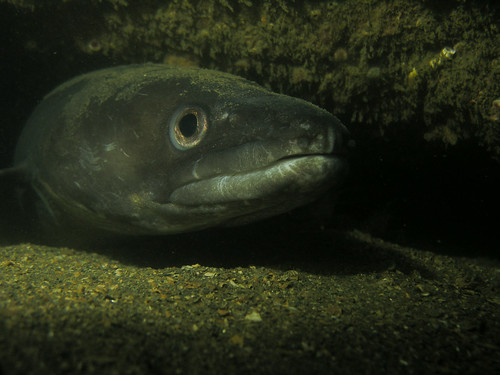
European conger, Ireland;
(Photo by mkrzysztofowicz)
It is believed that conger eels migrate to spawn in the deep sea, where they then die. Like other eel families, conger eels start out as tiny transparent larvae known as leptocephali. In Japan, the leptocephali of the white-spotted conger are known as noresore (のれそれ), and are actually eaten as a seasonal delicacy in certain prefectures.

Noresore
While the majority of tropical conger eel species live in the ocean depths, there are species which do inhabit shallow inshore waters, although they don't seem to be as well-known as their relatives from temperate climates.
The moustache conger (Conger cinereus) is widespread throughout the tropical Indo-Pacific, ranging from East Africa and the Red Sea in the west, all the way to Hawaii in the east. It earns its common name from the prominent and well-developed flanges on the upper lips.
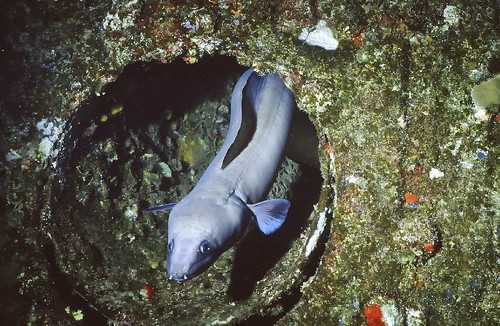
Moustache conger, Hawaii;
(Photo by jbarc)

Moustache conger, Hawaii;
(Photo by shappell)
This species is known to occur in Southeast Asian waters, and although I cannot find a list of conger eel species recorded in Singapore, I won't be surprised if there are moustache congers living in the seas around Singapore.
Another conger eel that might be encountered by divers in the region is the barred conger (Poeciloconger fasciatus). This reef-associated species is similar to the snake eels, in that it buries itself in the sand during the day.
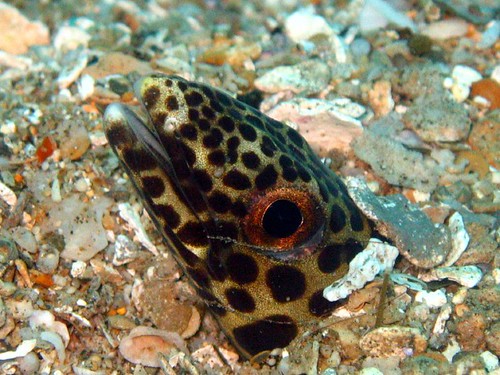
Usually, this is all that people ever see of this eel.
Barred conger, Hawaii;
(Photo by mauiscubasteve2)

The barred conger gets its name from the brown bars on its body.
Barred conger, Hawaii;
(Photo by doctorkb)
However, there are members of the conger eel family which are found in shallow tropical waters, but which look and behave quite differently from the conger eels which we have looked at. These are the 33 species of garden eels, which form the subfamily Heterocongrinae.
Garden eels were once thought to form a separate family of their own (F. Heterocongridae), but now it is thought that they are in fact a subfamily of the conger eels. There are 2 genera, Gorgasia and Heteroconger, distributed in warm waters of the Indo-Pacific, with a handful found in the tropical Atlantic.
The largest species of garden eel grows up to 1.2 metres in length, although most species are less than 1 metre. These eels live in large colonies in sandy areas and seagrass beds exposed to currents. Using its hard and stiffened tail, a garden eel digs a long tubular burrow in the sand, which is held together by the slime secreted by the eel. Once its burrow is built, a garden eel almost never leave their burrows, even to feed. It emerges to feed on zooplankton and smaller creatures drifting in the currents above, and even so, its tail still remains safely hidden in the burrow.

White-spotted garden eel (Gorgasia maculata), Sabah;
(Photo by Coppertane)
The sight of hundreds of these long slender eels, poking up from the seabed, their bodies swaying in the current, does look like some bizarre undersea garden.

Colony of white-spotted garden eel, Dumaguete;
(Photo by Mickle Huang)
Should they be disturbed, the garden eels instantly retreat into their burrows. Being extremely shy and skittish, they present a real challenge for divers trying to photograph them.
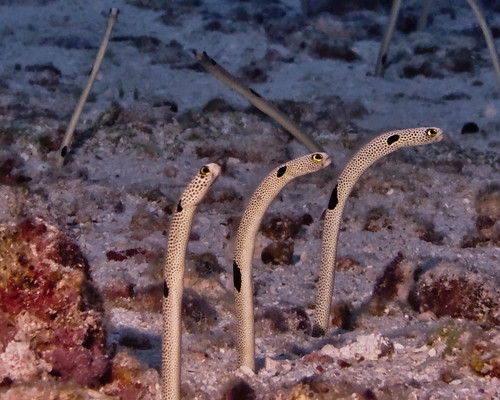
Spotted garden eel (Heteroconger hassi), Palau;
(Photo by t_bretl)
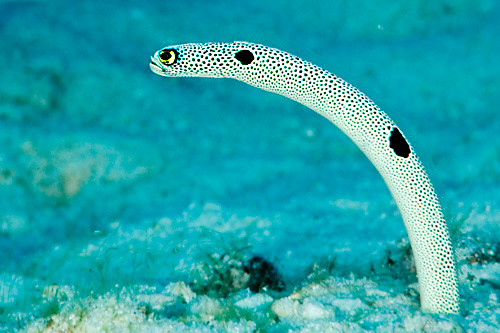
A photo of an individual spotted garden eel, Christmas Island;
(Photo by Rob Hughes)
I couldn't find much information about how garden eels reproduce, although some sites say that these eels don't leave their burrows even to mate; individual eels merely reach over and find a neighbour of the opposite sex, intertwine their bodies together, and release their eggs and sperm simultaneously.
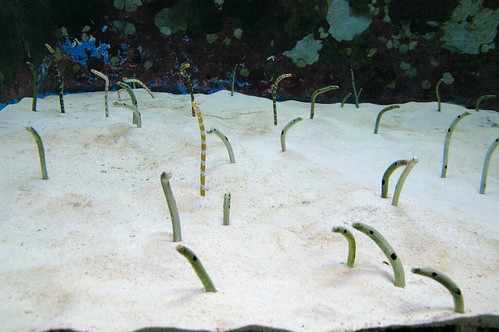
Mixed-species exhibit of spotted garden eel and splendid garden eel at Okinawa Churaumi Aquarium, Okinawa;
(Photo by pelican)
Garden eels are quite popular in public aquaria, where the most commonly exhibited species are the spotted garden eel and splendid garden eel (Gorgasia preclara).
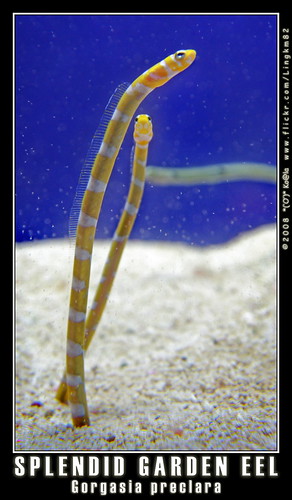
Splendid garden eel at Underwater World Singapore, Sentosa;
(Photo by Ko@la *('O')*)
The 2 species are often displayed in a mixed-species exhibit, although I have my doubts as to whether both species would actually be found living together in a mixed colony in the wild.
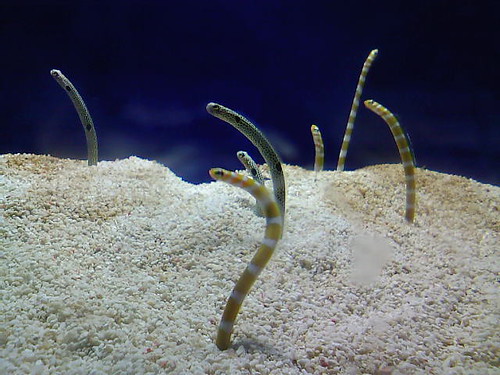
Mixed-species exhibit of spotted garden eel and splendid garden eel at Underwater World Singapore, Sentosa;
(Photo by DanceMacabre)
Garden eels do pop up from time to time in the aquarium trade. Obviously, they require aquariums with a deep layer of sand that enables them to burrow. Even though they live in large groups, they are still territorial and fiercely protective of the area immediately around their burrows, so a captive colony of garden eels should have adequate space, both horizontal and vertical, for each eel. While these eels won't try to eat crustaceans or other fish too big to fit into their mouths, they are vulnerable to harassment from aggressive tankmates. They will also need a current that will bring them a regular supply of plankton and tiny crustaceans. As can be seen, these are fish best left to the experts.
Moving on, we shall look at another family of eels with representatives in Southeast Asia, the pike conger eels.
In the post which helped inspire this series on eels, the person who submitted the article to STOMP identified the eels in his photos as pike conger, even though they appear to be moray eels.
So, what exactly is a pike conger eel? Why is its name a combination of pike (Esox spp.) and conger eel? We've already looked at conger eels, but what similarities do pike conger eels share with the fearsome freshwater predatory fish known as pikes (F. Esocidae)?
Compared to moray eels, snake eels, and conger eels, pike conger eels are a much less diverse group, with only 13 described species found across the tropical Atlantic, Indian and Pacific Oceans. Ranging from 60 centimetres to 2.5 metres in length, these predators are found over a wide range of habitats; some inhabit estuaries and coastal waters, whereas others are found only in the ocean depths, more than 300 metres beneath the surface.

I think the fish in this photo are some sort of pike conger eel.
(Photo by washako16)
I could not find anything about the behaviour of these fish, nor could I find any photos of live pike conger eels besides the 2 that I've shown so far. Based on the photo of the daggertooth pike conger with its head poking up from the sediment, I would presume that like snake eels, some species of pike conger eel bury themselves in the seabed during the day, emerging at night to feed on fish, crustaceans and cephalopods. Their mouths are filled with long sharp teeth, enabling them to get a good grip on wriggling prey.

The toothy grin of a common pike conger (Muraenesox bagio).
(Photo by Ian Merrington)
Most of the members of the family grow to quite large sizes; the smallest species reaches a length of 60 centimetres. The largest species is the Indian pike conger (Congresox talabonoides), with a length of 2.5 metres. The common pike conger, daggertooth pike conger, red pike conger (Cynoponticus coniceps) and Guinea pike conger (Cynoponticus ferox) are other species that can reach 2 metres in length.
Some species support commercial fisheries; these include the yellow pike conger (Congresox talabon), Indian pike conger, red pike conger, Guinea pike conger, Guayana pike conger (Cynoponticus savanna), common pike conger and daggertooth pike conger. The daggertooth pike conger features in Japanese cuisine, where it is known as hamo (鱧).



3 commercially important species of pike conger eel.
Left: Indian pike conger, Singapore;
(Photo by Eileen Chua)
Centre Guayana pike conger, Guianas;
(Photo by Keiichi Matsuura)
Right: Common pike conger, Pakistan;
(Photo by Mohammed Moazzam Khan)
Locally, we haven't encountered pike conger eels on our shore trips, although I do know that at least 2 species, the Indian pike conger and common pike conger, are known to occur in our waters.
Coming up next, the epic journey of the freshwater eels and the unsustainable demand for unagi.
Part 1: Moray eels (Muraenidae)
Part 2: Snake eels (Ophichthidae)
Part 3: Conger eels (Congridae) and Pike conger eels (Muraenesocidae) (this post)
Part 4: Freshwater eels (Anguillidae)
Part 5: Spaghetti eels (Moringuidae) and false moray eels (Chlopsidae)
Part 6: Non-eels